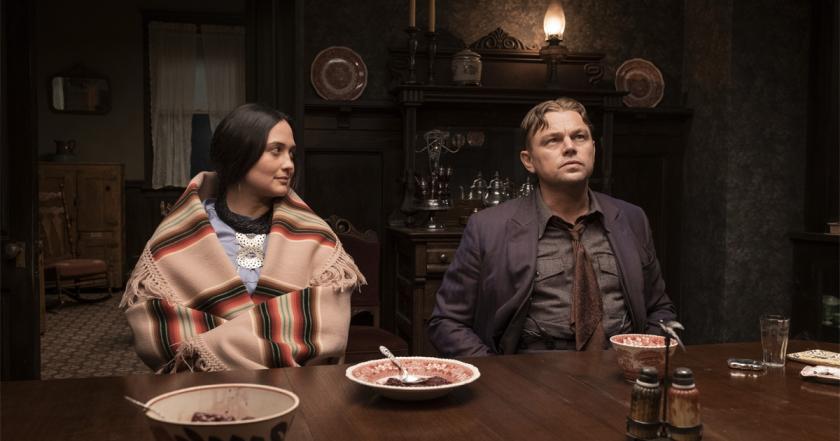At the centre of Martin Scorsese’s Killers of the Flower Moon, closely adapted from the 2017 non-fiction book by the investigative journalist David Grann, is the true story of how the white former doughboy Ernest Burkhart (Leonardo DiCaprii) was inveigled into slowly poisoning his Native American wife Mollie (Lily Gladstone) for her share of oil wealth in 1920s Oklahoma.
At least sixty – possibly hundreds – of Osage were murdered by whites for this reason. Scorsese, with his practiced eye for squalid crime scenes, spiderous psychopaths, and murderous odd-job men, depicts a passel of the homicides as he drives the film toward a near-apocalyptic inferno, the tangential burning of a farm in an insurance scam suggesting Osage County has become a metaphor for hell on earth. Silhouetted against the flames, a distant Christ figure – his arms suspended on a stick, echoing the iconic pose of James Dean’s oilman in Giant – hints that Mollie, at death’s door in her bedroom, hasn’t been forsaken.
Scorsese combines his sprawling crime thriller (it’s more that than a conventional Western, despite the playing of John Ford’s favourite hymn “Shall We Gather at the River?”) with an intimate mixed-race love story, one that curdles. This makes for a microcosmic approach to the Native American genocide that couldn’t be more wrenching.
Though the killings of the Osage were carried out furtively, they nonetheless recall the pitched massacres and displacements the author Dee Brown described, tribe by tribe, in Bury My Heart at Wounded Knee (1970). Seminally giving voice to tribespeople, Brown’s book ends with the closing of the frontier. Had he extended it beyond 1890, he would surely have incorporated the homicides of the Osage shot or poisoned by whites like Burkhart who had married into the tribe and, as male family members, stood to inherit the lucrative “headrights” yielding royalties to the oil discovered on the tribe's land in 1897.
Grann has spoken of the Native genocide as America’s “original sin”, the notion of Old Testament crime presumably resonating with Scorsese, who had once considered making a Bury My Heart movie. Opening in May 1921, the Killers book initially conveys Mollie’s fears as she awaits the return of her hard-drinking, gun-toting older sister Anna Brown, missing for three days. The comparatively modest-living Gray Horse resident Mollie soon learns that Anna’s body has been found in a ravine, a bullet hole in the back of her head.
Amid other Osage murders, including that of Mollie’s first husband Henry Roan, Mollie’s surviving sister Rita Smith and her husband Bill are killed when their house is blown up in March 1923. The pattern had begun in 1918 when Minnie, Bill’s first wife, became the first of the sisters to die. She succumbed to an undiagnosed wasting disease, as did their mother Lizzie two months after Anna’s death.
 Watching Scorsese’s densely plotted film, it’s important to keep straight the details of the “Reign of Terror” as it unfolds, a tapestry of racist evil intensified by the casual victimization of humans treated like game. “Oh, that’s different,” says one reluctant family man (Ty Mitchell) who agrees to do a hit on learning his victim will be an Osage, not a fellow white. (Pictured above: JaNae Collins, Lily Gladstone, Cara Jade Myers, and Jillian Dion as the sisters)
Watching Scorsese’s densely plotted film, it’s important to keep straight the details of the “Reign of Terror” as it unfolds, a tapestry of racist evil intensified by the casual victimization of humans treated like game. “Oh, that’s different,” says one reluctant family man (Ty Mitchell) who agrees to do a hit on learning his victim will be an Osage, not a fellow white. (Pictured above: JaNae Collins, Lily Gladstone, Cara Jade Myers, and Jillian Dion as the sisters)
Mollie had Ernest to comfort her and help her cope with diabetes, as well as the support and friendship of his uncle, William Hale, the so-called King of the Osage Hills, a rich cattle rancher, civic leader, and deputy sheriff in nearby Fairfax.
A third of the way into the book, Grann diverges from Mollie’s predicament to follow the undercover investigation of the killings led by the Bureau of Investigation special agent Tom White, a former Texas Ranger assigned to the case by J. Edgar Hoover in 1925. Scorsese originally intended White to be the film’s protagonist and DiCaprio to play him. After reconceiving the project, the director and his co-writer Eric Roth focused it on Burkhart, whose role in Mollie’s demise became the moral quandary – or void – at its heart. White (played with deceptive affability by Jesse Plemons) and his team enter the film at the two-thirds mark after it has laid out, in a mesmerising operatic flow that owes greatly to Thelma Schoonmaker’s cutting, a saga of sickening betrayals and executions.
Some reviewers have complained about the film’s 204-minute running time, but Scorsese needed that to show how the story unfolds as an intricate tapestry of evil scheming and brutal acts prolonged over years. Whereas the book builds suspense around the procedural aspects of the case, the film quickly discloses that Hale masterminded the killings from his Olympian vantage point as the tribe's chief beneficiary, the builder of hospitals and dance schools. Robert De Niro plays him as a self-righteous, Bible-spouting robber baron-type – charismatic but unsmiling – with whiffs of the madness driving Walter Huston’s rancher in The Furies and the lordliness and plausibility of John Huston’s corrupt industrialist in Chinatown.
In the shadows behind Hale is a pack of bloodsucking white offiicials and professionals, such as the attorney (Gene Jones) who manages Mollie’s money as her guardian (she being deemed an “incompetent” legally) and parades as a Klansman on public holidays. References to another Oklahoma atrocity linked to oil wealth, the 1921 Tulsa race riots that caused 26 black and 10 white deaths and the interning of 6,000 blacks, underscores the film’s commentary on the systemic racism that still obtains in the US.
Scorsese has become a peerless director of unhurried, rhythmically paced historical subjects punctuated with staccato bursts of violence. Kundun (1997) and Silence (2016) were major advances. If Gangs of New York (2002), The Aviator (2004), and The Irishman (2019) partook of myths as much as truths, the latter gangster film presaged Killers of the Flower Moon especially by showing how matter-of-fact violence is American powerbrokers' time-honored tool of choice, picked up and used when necessary.
Whether The Irishman's Frank Sheeran (played by De Niro) shot the Teamsters labour leader Jimmy Hoffa or not, someone like him did, a secret sharer, another William Hale, in the dark arts used in futilely attaining “the green light” – as aspired to by contemporaneous doughboy turned bootlegger Jay Gatsby – of material wealth.
 DiCaprio’s Burkhart is an anti-Gatsby. Naive and cretinous-looking with his jutting jaw and perma-frown, he is easily enlisted by his Macchiavellian uncle to find an Osage wife, and he woos Mollie after becoming her go-to taxi driver on shopping expeditions. She falls in love with him, they marry, and have three kids. With no little TLC, he gives Mollie her insulin shots alongside the poison additive prescribed her by the two Shoun physician brothers in league with Hale. (Pictured above: Robert De Niro and Leonardo DiCaprio)
DiCaprio’s Burkhart is an anti-Gatsby. Naive and cretinous-looking with his jutting jaw and perma-frown, he is easily enlisted by his Macchiavellian uncle to find an Osage wife, and he woos Mollie after becoming her go-to taxi driver on shopping expeditions. She falls in love with him, they marry, and have three kids. With no little TLC, he gives Mollie her insulin shots alongside the poison additive prescribed her by the two Shoun physician brothers in league with Hale. (Pictured above: Robert De Niro and Leonardo DiCaprio)
The film’s mystery resides in how much Burkhart is or isn’t in denial about what he’s doing to Mollie, DiCaprio carrying it with the most ambiguous performance of his career, perhaps his best. Of Blackfeet, Nez Perce, and white descent, Gladstone shone as the woman delusionally fixated on Kristen Stewart’s lawyer in Certain Women and excels here harbouring romantic delusions again.
Serenely accepting at first that Burkhart is dim, Mollie eventually gleans that the husband who apparently loves her is intent on uxoricide, though the penny drops with glacial slowness. Though the film prostrates her for much of its second half, it crucially grants her agency she was denied in real life, putting her alert mind and enfeebled body on a D.C.-bound train as part of the 1824 Osage delegation to President Coolidge that sparked the Bureau’s investigation. Gladstone carries the weight of her race as Mollie's struggle to survive acquires a holy aura.
Tonally enriched by the late Robbie Robertson’s low-mixed score – a sinister amalgam of Native American drumming and eerie blues – Killers of the Flower Moon is at its most haunting in the contrasting of Plains Indian rituals with flashes of modern artifice: the early newsreel that chronicles how the Osage spent their oil money; a crass entertainment with a moving finale that explains what became of Mollie after she and the other characters have left the screen.
These epherneral episodes, produced with the whites' electric magic, make one hanker to see again the “Copacabana” shot by cinematographer Rodrigo Prieto that winds nostalgically through Mollie’s house and takes in her different clan members during a gathering, including Lizzie (Tantoo Cardinal) and Anna (Cara Jade Myers). They variously idle, work, snub each other, tangle, and bicker – but they are all still vibrantly alive.














Add comment